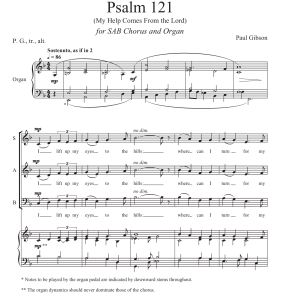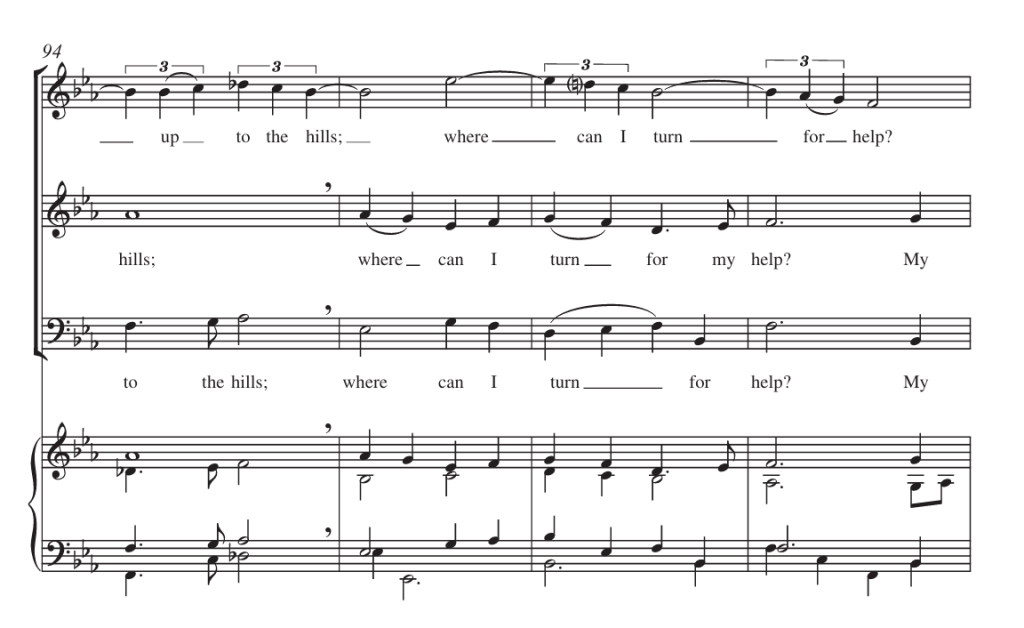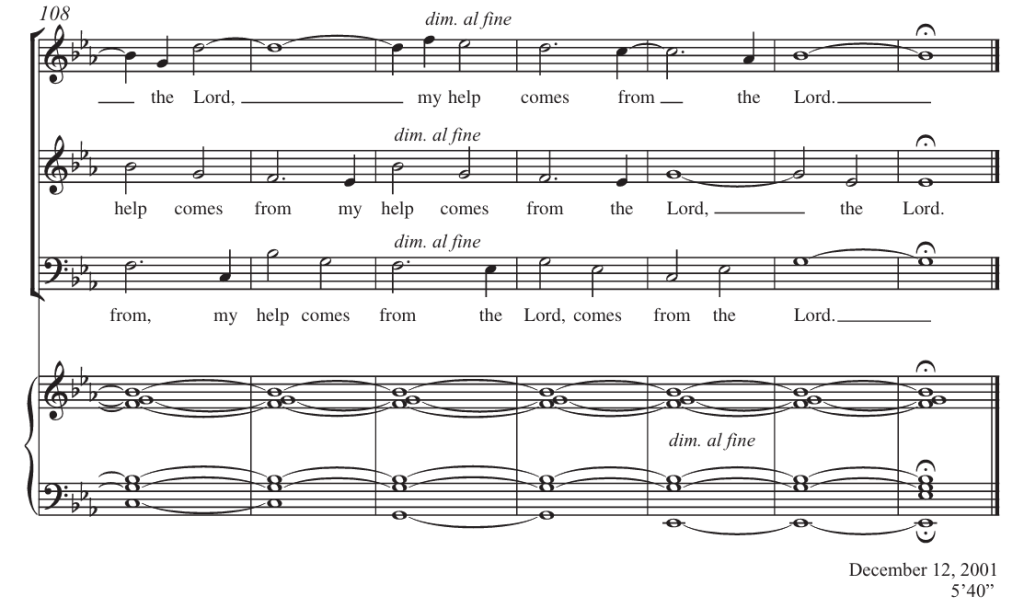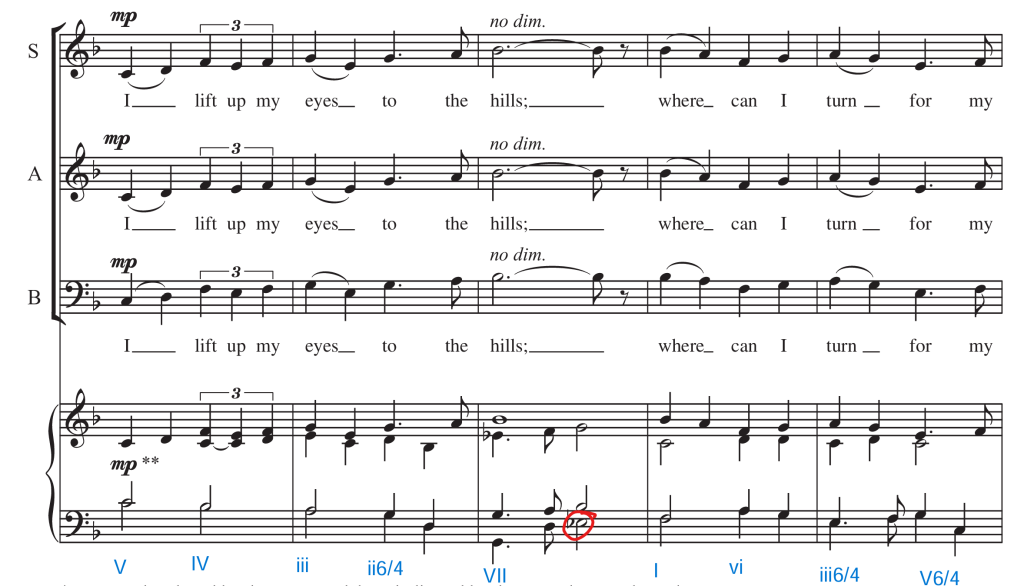Psalm 121 by Paul Gibson
Introduction
Psalm 121, as set to music by Paul Gibson, is a hymn-like piece for choral music that uses the entire text from Psalm 121, treating verses 1–2 as a refrain: “I lift up my eyes to the mountains—where does my help come from? My help comes from the LORD, the maker of heaven and earth.”
Paul Gibson received composition degrees from three separate colleges, and has had his music performed all over the world, including Walt Disney Concert Hall and Carnegie Hall, among many others. Groups that have performed his music include three Grammy-winning ensembles, the Los Angeles Philharmonic, the Debussy Trio, and countless others. In 1987, he was commissioned to arrange hymns for Pope John Paul’s visit to Los Angeles. Gibson has made quite a name for himself composing religious music.
Overview
Below is a diagram of the piece to show the main features, including verses, choruses, interludes with modulations, or important/unique points in the piece.

The piece has many elements associated with hymns, including notably a chorale-style organ accompaniment in four parts and a syllabic setting of a relatively long text. This fits well with what the composer has created in his time. Many of his works are more religiously based, both aurally and in text:
I lift up my eyes to the hills; Where can I turn for my help? My help comes from the Lord Who made heaven and earth, My help comes from the Lord. God does not allow your foot to be moved; your Guardian does not slumber. Indeed, the one who watches over Israel Neither slumbers nor sleeps. [Refrain] It is the Lord who is your keeper, The shade at your right hand. Behold the sun harms you not by day, Nor the moon by night. [Refrain] The Lord protects you from all evil, Keeps watch over your soul. The lord watches over your coming and your going now and forever and ever. [Refrain]
Analysis
Text
In terms of text in a musical piece, it is important to pay attention both to the repeated sections of text, but also to those that are unique in the piece. Within the text, we have the section which we see come back after each stanza of text.
I lift up my eyes to the hills; Where can I turn for my help? My help comes from the Lord Who made heaven and earth, My help comes from the Lord.
This might indicate its importance within the context of the piece. Musically, this section only changes in the voicings and the modulations introduced within each instrumental interlude; it does not change text, except for the final section of the piece, which slows down and somewhat elongates the text, making it stand out more than usual. Until the end, the text doesn’t stand out in the texture of the rest, but this last section indicates the importance of the words: My help comes from the Lord.
Form
In several sections of the piece, the pattern is quite clear; this seems like a verse-chorus form for the most part, with a slight variation on the final chorus to end the piece with, to indicate the importance of that final text that has been repeated throughout. The modulations, however, are unusual for verse-chorus form. What is interesting is the fact that the modulations don’t just come before or after the choruses, or before or after the verses in a pattern. They come in between every single section of the piece, changing each section just slightly to maybe change the feeling of the text overall, by modulating up or down.
Rhythm and Meter

The first thing I want to point out is the note for conducting/counting at the top of the piece. The text reads “Sostenuto, as if in 2.” Aurally, this is clear from the rate of the introduction and the stressed syllables of text. Each of the first two measures has a single syllable in the first half, followed by across-the-beat triplets, emphasizing the two stresses of the measure on notated Beats 1 and 3.
At measure 22, we see a tempo change, which is why the 2 conducting pattern is important. We now use that established beat to find the new tempo of the piece.
For the most part, I would say this piece follows expectations of a hymn, with many of the rhythms repeating throughout the piece. This might be a good sight singing piece for an intermediate choir because of the repeated sections and rhythms.
Texture
In the first chorus section, all vocal parts are homorhythmic and homophonic. We start to see some deviations from this directly after the first modulation, when the bass sings alone at the beginning of the first verse. When the treble voices begin singing, they are singing a harmony, which is just the beginning of the variation in the texture throughout this piece. In measure 28, we start seeing full chordal texture throughout all three voice parts. By the end of the first verse, we don’t have any contrasting dotted rhythms between the parts, but we do see some variation in the rhythms with unaligned quarter and eighth notes between the treble voices and the bass voice. This progression of varied rhythms and chord shifts in the vocal parts continues on throughout the entirety of the piece, with each verse and chorus portraying a slighted variation on the chord progressions. In various sections, we start to see some slight countermelody in the soprano part. By measure 94, can see a clearly distinct rhythm and melody in the soprano part to provide even more contrast and interest in the last two pages of the piece.

By the last page, the rhythms become a bit less complex; we start to see consistently more half notes, suggesting the approach of the end of the piece. Also, as mentioned previously, the final chorus has a slightly different pattern than the rest of the piece, not only in the rhythm, but also in the dynamics and the organ accompaniment. The lower two voices repeat “my help comes from” in canon while the soprano sings a freer line and the organ builds up its final E-flat major add2 chord.

Harmony
The harmonic progressions in this piece are quite different from what we would normally see in a hymn book. However, the good news is that the sections, even though they modulate at each interlude, keep the same pattern of progressions throughout the majority of the piece. The only sections I might separate from the main verse-chorus sections are the instrumental introduction at the very start, and the ending chorus, which repeats some text and music.
Our first established key officially begins at the last measure of the instrumental introduction. This last F major chord doesn’t fit into the chord pattern that is being followed. The progression in the first two measures then repeats up a fourth, beginning with the A minor chord. However, the pattern breaks near the end of the intro, with the G chord and ending with the F major chord.

The remainder of the piece follows the same two chordal patterns for most of the remainder of the piece, only in different keys each time; these are the verse pattern and the chorus pattern. The chorus pattern is quite fascinating.

In the first three measures, for example we see an interesting chord progression. The chorus begins on a five chord, which is not necessarily unusual on its own. However, it continues in an unorthodox fashion. The pattern of chords descends in a step-wise pattern, starting at V, then IV, then iii, and so on. The most fascinating thing about this particular section might be the fact that while the chords and bass descent, the voices move upward. The following phrase begins on a I chord, but remains only for a moment, then moves to a feeling of minor and almost sadness with the minor vi chord followed by the minor iii chord.
Now we travel to the verse. In the first verse, we have already modulated once from the original F major to Db major. The beginning phrase of this verse has a strange chord progression that feels a little jarring. It never really sounds like it is going to resolve or getting anywhere near resolving. In the first phrase of the bass voice, the progression both begins and ends on a root-position one chord, but everything in between is all over the place, in terms of following a recognizable chord progression. However, in the next line when the treble voices come in, the progression, visually, is a bit of a different story. While we don’t normally see chords set in order like this, especially not in root position, but that is what we see here. There seems to be a juxtaposition between the bass and treble voicings. Along with that, we see a pattern that was somewhat established in the first chorus analyzed above. While in the first chorus we saw a directly descending chord pattern and ascending voices, we now see the opposite, a directly ascending chord pattern (in first inversion) with slightly descending voices. This starts to create some complexity and conflict within the voices and between the sections of music in all.

